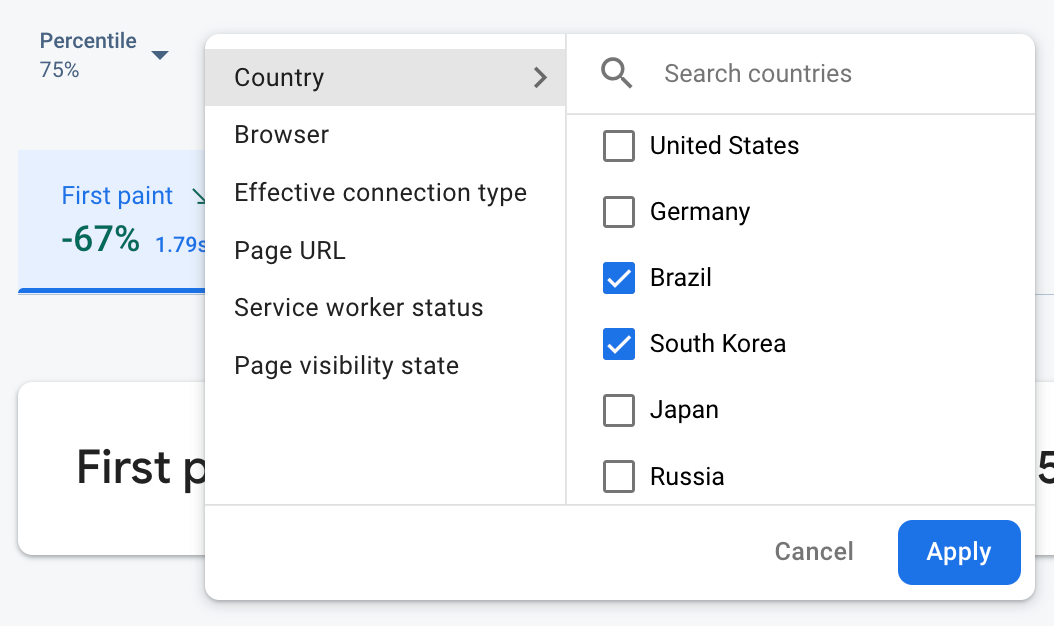No Performance Monitoring, é possível usar atributos para segmentar dados de desempenho e se concentrar na atividade do app em diferentes cenários reais.
Depois de clicar no nome de um trace na tabela de traces (na parte de baixo do
painel Desempenho), você poderá detalhar as
métricas de interesse. Use o botão
 Dados do Monitoramento de desempenho do Firebase sendo filtrados por atributo" />
Dados do Monitoramento de desempenho do Firebase sendo filtrados por atributo" />
- Filtre por URL da página para visualizar dados de uma página específica do site.
- Filtre por Tipo de conexão vigente para saber como uma conexão 3G afeta o app.
- Filtre por País para garantir que o local do banco de dados não está afetando uma região específica.
Atributos padrão
O Performance Monitoring coleta automaticamente uma variedade de atributos padrão, dependendo do tipo de trace.
Além desses atributos padrão, é possível criar atributos personalizados nos traces de código personalizado para segmentar dados por categorias específicas no app. Por exemplo, em um jogo, é possível segmentar os dados por fase.
Atributos padrão coletados para apps da Web
Por padrão, todos os traces para apps da Web coletam os seguintes atributos:
- Navegador
- País
- Tipo de conexão vigente
- URL da página
- Status de service worker
- Estado de visibilidade
Como coletar dados do usuário
Criar atributos personalizados
Crie atributos personalizados em qualquer um dos traces de código personalizado instrumentados.
Use a API Trace do Performance Monitoring para adicionar atributos personalizados a traces de código personalizado.
Para usar atributos personalizados, adicione códigos ao app que definam o atributo e o associem a um trace de código personalizado específico. É possível definir o atributo personalizado a qualquer momento entre o início e a interrupção do trace.
Observações:
Os nomes dos atributos personalizados precisam atender aos seguintes requisitos:
- Sem espaço em branco no início ou no fim e sem sublinhado (
_) no início - Sem espaços
- O comprimento máximo é de 32 caracteres
- Os caracteres permitidos para o nome são
A-Z,a-ze_
- Sem espaço em branco no início ou no fim e sem sublinhado (
Cada trace de código personalizado pode registrar até cinco atributos personalizados
Verifique se os atributos personalizados não contêm informações que o Google pode usar para identificar uma pessoa
Saiba mais sobre essa diretriz
Web
import { trace } from "firebase/performance"; const t = trace(perf, "test_trace"); t.putAttribute("experiment", "A"); // Update scenario t.putAttribute("experiment", "B"); // Reading scenario const experimentValue = t.getAttribute("experiment"); // Delete scenario t.removeAttribute("experiment"); // Read attributes const traceAttributes = t.getAttributes();
Web
const trace = perf.trace("test_trace"); trace.putAttribute("experiment", "A"); // Update scenario trace.putAttribute("experiment", "B"); // Reading scenario const experimentValue = trace.getAttribute("experiment"); // Delete scenario trace.removeAttribute("experiment"); // Read attributes const traceAttributes = trace.getAttributes();
